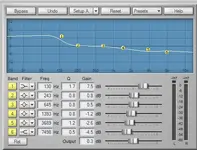Middleman
Professional Amateur
Just a heads up on the 24/96.
First, its a great starting out card. Good sound but not very 3 dimensional. Another item is that it has a midrange emphasis which can catch you off guard on your mixes. This means that volume wise you will over compensate your low and high end and under compensate your midrange which you will notice when you take your mixes to car or house stereos.
Once you learn your way around the EQ profile of the card your mixes will be more transferable. I used one for over 3 years and was very pleased with the performance. If you get a preamp with SPDIF out you can use all 4 available channels on the card. As pointed out, two analog and 2 SPDIF channels gives you 4 simultaneous tracks.
Not sure if they still provide Giga 24 in the package but it is a nice peice of software for free.
First, its a great starting out card. Good sound but not very 3 dimensional. Another item is that it has a midrange emphasis which can catch you off guard on your mixes. This means that volume wise you will over compensate your low and high end and under compensate your midrange which you will notice when you take your mixes to car or house stereos.
Once you learn your way around the EQ profile of the card your mixes will be more transferable. I used one for over 3 years and was very pleased with the performance. If you get a preamp with SPDIF out you can use all 4 available channels on the card. As pointed out, two analog and 2 SPDIF channels gives you 4 simultaneous tracks.
Not sure if they still provide Giga 24 in the package but it is a nice peice of software for free.

